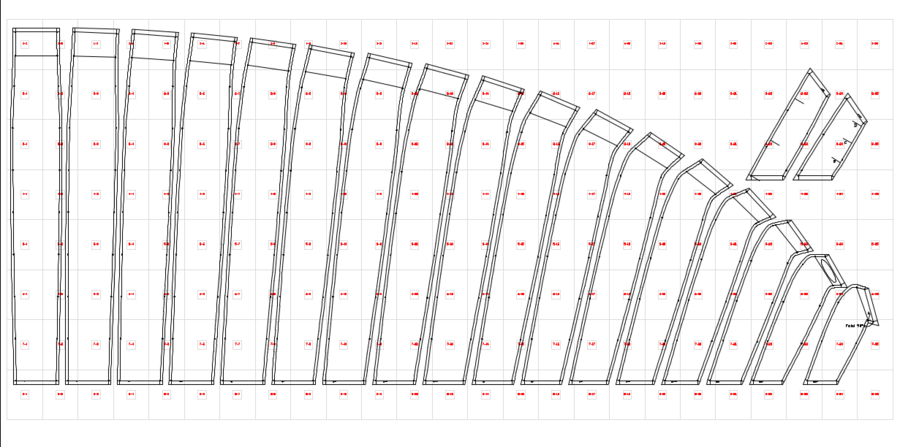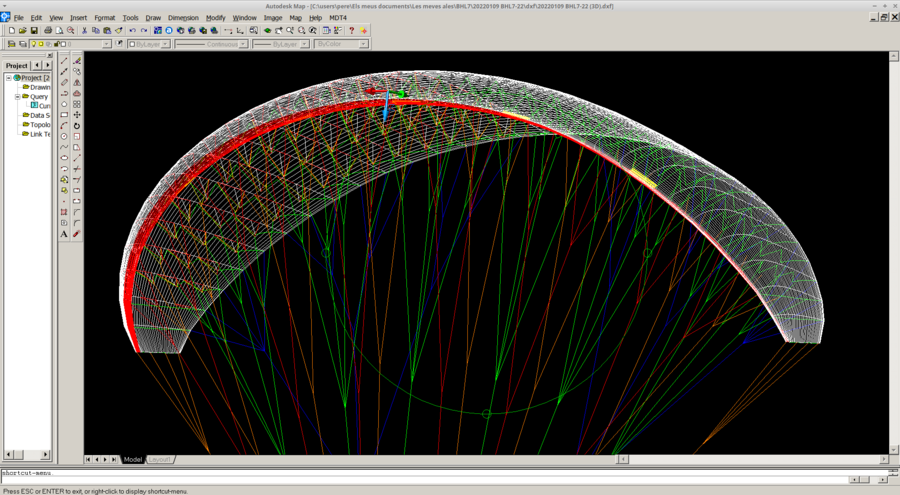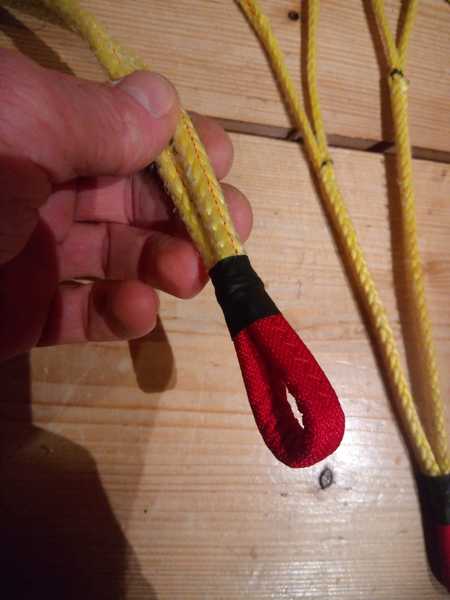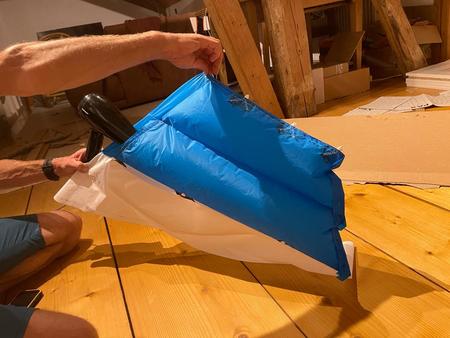
[en] [fr] [de] [ru]
BHL7
BARRETINA HYPER LITE 7
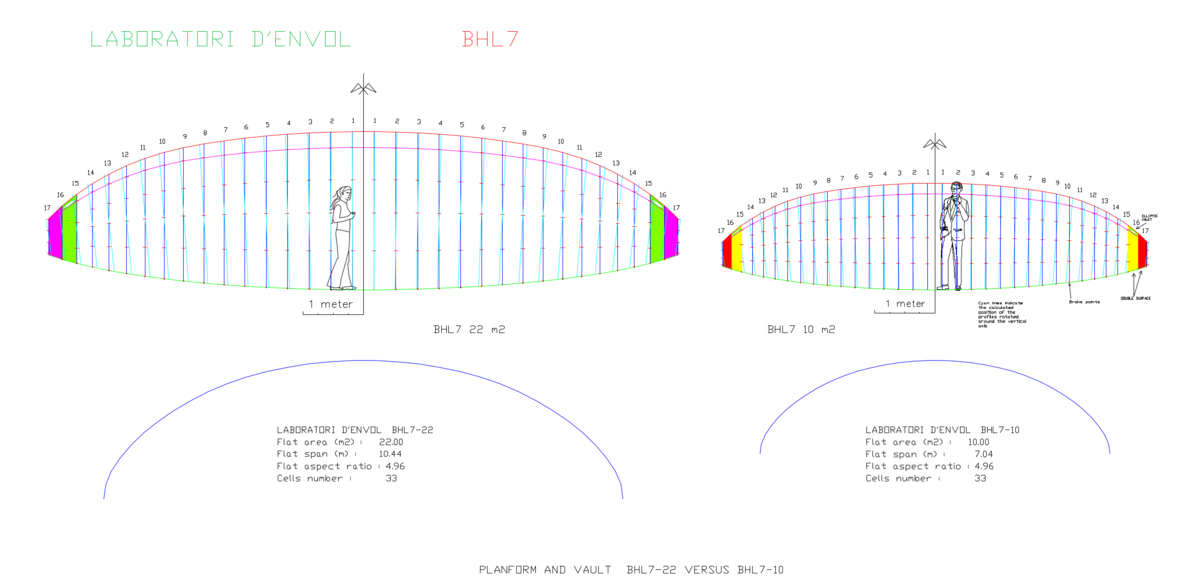
1. DESCRIPTION
2. TECHNICAL ESPECIFICATIONS BHL7
BARRETINA HYPER LITE 7

Figure 1. BHL7 sizes 22 and 10 comparative
1. DESCRIPTION
BHL7 is the name of the new single skin paraglider 2022 of the Laboratory. At first glance, it is a BHL2-evo
model, because its basic geometry is exactly the same. However, we have
added some experimental improvements, and with the aim of not creating
more confusion with the BHL2 model versions, we have named this 7,
which is the next corresponding number in the hyperlight series. The
changes are as follows:
1. Nose modified airfoil
Based on a classic four-triangle BHL2 profile, the profile nose has been modified, making the lower surface exit angle above the horizontal. That is, it is an "epsilon" angle profile (as explained in the BHL3 paragliding studies). With this, less aerodynamic drag is expected. This modification of the profile nose has also been applied to the 16 m2 Suluk2, and to the size 33 m2 of the BHL5. The profile of the 2016 BHL3 also had a similar modification.

Figure 2. Nose modified airfoil with with an epsilon angle above the horizontal, at the nose exit edge.
Includes an optional nylon rod above the "D" triangle to minimize wrinkles in this area
1. Nose modified airfoil
Based on a classic four-triangle BHL2 profile, the profile nose has been modified, making the lower surface exit angle above the horizontal. That is, it is an "epsilon" angle profile (as explained in the BHL3 paragliding studies). With this, less aerodynamic drag is expected. This modification of the profile nose has also been applied to the 16 m2 Suluk2, and to the size 33 m2 of the BHL5. The profile of the 2016 BHL3 also had a similar modification.

Figure 2. Nose modified airfoil with with an epsilon angle above the horizontal, at the nose exit edge.
Includes an optional nylon rod above the "D" triangle to minimize wrinkles in this area
2. Progressive rotation of profiles around the "Z" axis
This is not an aesthetic curiosity. During the summer of 2021 we studied in detail that rotating the planes of the profiles in three axes X, Y, Z can be achieved that these are perfectly oriented with the flight path. That is, the profiles work with their highest aerodynamic efficiency. And, especially in the case of single-skin paragliders, allows the triangles to offer the minimum resistance due to exposure to airflow. That is, this alignment with the flow is more important in single skin paragliders, than in double surface paragliders where the diagonals are perfectly faired inside the double surface.
This alignment allows us to calculate more accurately the angle of attack "seen" by the profiles in relation to the flight path, and at the same time allows us to reduce the maximum geometric torsion (washin). Angles washin and Rot_z used in BHL7 (printed in section 3 of lep-out.txt):
Rib - Chord - washin - beta - Rot_z
-------------------------------------------------
1 262.65 0.000 1.53 0.22
2 261.53 0.028 4.31 0.61
3 259.27 0.084 7.23 1.02
4 255.90 0.167 10.15 1.43
5 251.39 0.279 13.00 1.82
6 245.72 0.419 17.10 2.38
7 238.90 0.588 21.21 2.93
8 230.88 0.786 25.05 3.43
9 221.59 1.016 28.90 3.92
10 210.01 1.303 32.74 4.39
11 195.90 1.652 36.59 4.84
12 179.24 2.064 41.19 5.34
13 160.02 2.540 47.35 5.97
14 138.42 3.074 53.11 6.49
15 114.55 3.665 59.33 6.99
16 88.44 4.311 75.16 7.86
17 59.85 6.500 89.34 8.13
washin ---> airfoil rotation around X axis
beta ---> airfoil rotation arount Y axis
Rot_z ---> airfoil rotation arounf Z axis
Note that in this paraglider we have used a maximum washin angle of 6.5º, while the BHL2 and BHL-evo use angles of 10º and higher. The BHL3 paraglider used an washin angle of only 4.5º with no tendency to fold ears during flight, and a slight tendency during the inflation phase. Here we have preferred to increase a little. The rotation angles in Z "Rot_z" fron 0.22º to 8.13º are the ones recommended by the program to achieve the best alignment of the profiles. See the results in the lep-out.txt) file section 12.

Figure 3. The cyan lines represent the Z-rotations of each profile.

Figure 4. Wingtip detail. Maximun Z rotation 8.13º.
3. Calculation of lines according to theory number "3".
The calculation of line alignments in space is done by calculating the weighted average of the relative weights of the anchor points and the chord length variations along the span. Remember that the previous BHL2s were calculated with the theory number "0" which only considers the geometric means of the anchor points. View first parameter in section 9 of leparagliding.txt

Figure 5. Lines models using case "0" (orange), case "3" with 35-35-20-10 distribution (green), and case "3" with 32-32-22-14 distribution (magenta).
BHL7 uses magenta case. View values set in section 18 of leparagliding.txt

Figure 6. BHL7 uses magenta model. The aim is to predict a distribution of forces as close as possible to reality, and thus a uniform tension throughout the sail.
This is not an aesthetic curiosity. During the summer of 2021 we studied in detail that rotating the planes of the profiles in three axes X, Y, Z can be achieved that these are perfectly oriented with the flight path. That is, the profiles work with their highest aerodynamic efficiency. And, especially in the case of single-skin paragliders, allows the triangles to offer the minimum resistance due to exposure to airflow. That is, this alignment with the flow is more important in single skin paragliders, than in double surface paragliders where the diagonals are perfectly faired inside the double surface.
This alignment allows us to calculate more accurately the angle of attack "seen" by the profiles in relation to the flight path, and at the same time allows us to reduce the maximum geometric torsion (washin). Angles washin and Rot_z used in BHL7 (printed in section 3 of lep-out.txt):
Rib - Chord - washin - beta - Rot_z
-------------------------------------------------
1 262.65 0.000 1.53 0.22
2 261.53 0.028 4.31 0.61
3 259.27 0.084 7.23 1.02
4 255.90 0.167 10.15 1.43
5 251.39 0.279 13.00 1.82
6 245.72 0.419 17.10 2.38
7 238.90 0.588 21.21 2.93
8 230.88 0.786 25.05 3.43
9 221.59 1.016 28.90 3.92
10 210.01 1.303 32.74 4.39
11 195.90 1.652 36.59 4.84
12 179.24 2.064 41.19 5.34
13 160.02 2.540 47.35 5.97
14 138.42 3.074 53.11 6.49
15 114.55 3.665 59.33 6.99
16 88.44 4.311 75.16 7.86
17 59.85 6.500 89.34 8.13
washin ---> airfoil rotation around X axis
beta ---> airfoil rotation arount Y axis
Rot_z ---> airfoil rotation arounf Z axis
Note that in this paraglider we have used a maximum washin angle of 6.5º, while the BHL2 and BHL-evo use angles of 10º and higher. The BHL3 paraglider used an washin angle of only 4.5º with no tendency to fold ears during flight, and a slight tendency during the inflation phase. Here we have preferred to increase a little. The rotation angles in Z "Rot_z" fron 0.22º to 8.13º are the ones recommended by the program to achieve the best alignment of the profiles. See the results in the lep-out.txt) file section 12.

Figure 3. The cyan lines represent the Z-rotations of each profile.

Figure 4. Wingtip detail. Maximun Z rotation 8.13º.
3. Calculation of lines according to theory number "3".
The calculation of line alignments in space is done by calculating the weighted average of the relative weights of the anchor points and the chord length variations along the span. Remember that the previous BHL2s were calculated with the theory number "0" which only considers the geometric means of the anchor points. View first parameter in section 9 of leparagliding.txt

Figure 5. Lines models using case "0" (orange), case "3" with 35-35-20-10 distribution (green), and case "3" with 32-32-22-14 distribution (magenta).
BHL7 uses magenta case. View values set in section 18 of leparagliding.txt

Figure 6. BHL7 uses magenta model. The aim is to predict a distribution of forces as close as possible to reality, and thus a uniform tension throughout the sail.
2. TECHNICAL ESPECIFICATIONS BHL7
